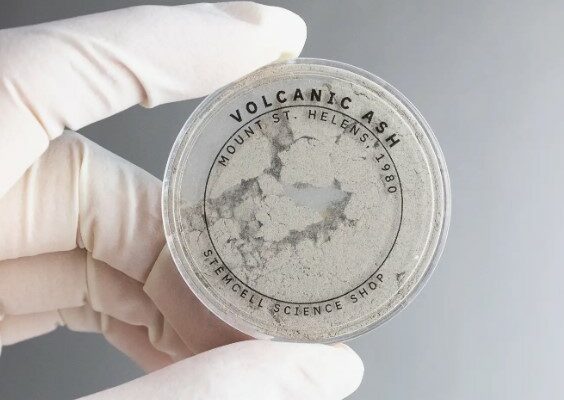The ash in this capsule was violently ejected from Mount St. Helens during the most disastrous volcanic activity in US history. The ash of every volcanic eruption is unique based on the chemistry, crystal content, temperature and dissolved gases of the erupting magma. Highly explosive eruptions, such as this one, produce brighter ash due to the higher silica content.
On March 27, 1980, a series of volcanic explosions and pyroclastic flows began at Mount St. Helens in Skamania County, Washington, United States. A series of phreatic blasts occurred from the summit and escalated until a major explosive eruption took place on May 18, 1980. The eruption, which had a Volcanic Explosivity Index of 5, was the most significant to occur in the contiguous United States since the much smaller 1915 eruption of Lassen Peak in California.
It has often been declared the most disastrous volcanic eruption in U.S. history. The eruption was preceded by a two-month series of earthquakes and steam-venting episodes caused by an injection of magma at shallow depth below the volcano that created a large bulge and a fracture system on the mountain’s north slope. A magnitude 5.1 earthquake shook Washington at 8:32:11 am PDT (UTC−7) on Sunday, May 18, 1980, causing the entire weakened north face to slide away, creating the largest landslide in recorded history. This allowed the partly molten rock, rich in high-pressure gas and steam, to suddenly explode northward toward Spirit Lake in a hot mix of lava and pulverized older rock, overtaking the landslide. The sound of the eruption was heard up to 700 miles away.
An eruption column rose 80,000 feet (24 km; 15 mi) into the atmosphere and deposited ash in 11 U.S. states and two Canadian provinces. Some areas were covered in debris, avalanches, and mudflows, and forests were scorched and scoured with hot gases. The ash reached 12 miles high and ash-fall was reported up to 1,500 miles away.
Less severe outbursts continued into the next day, only to be followed by other large, but not as destructive, eruptions later that year. Thermal energy released during the eruption was equal to 26 megatons of TNT.







